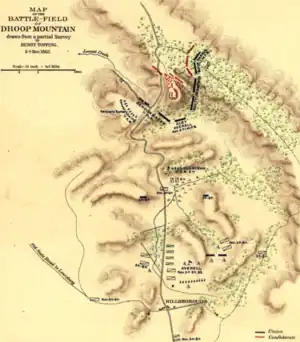
The following army units were involved in the Battle of Droop Mountain on November 6, 1863, near Hillsboro, West Virginia, in the American Civil War. Hillsboro, spelled "Hillsborough" on some maps from that century, is located in the mountainous terrain of Pocahontas County, West Virginia. A Union brigade commanded by Brigadier General William W. Averell defeated a smaller Confederate force commanded by Brigadier General John Echols and Colonel William L. "Mudwall" Jackson. A second Union force commanded by Brigadier General Alfred N. Duffié, tried to prevent the Confederate retreat, but did not engage at Droop Mountain. Aware of Duffié's troops, Confederate forces escaped before he arrived.[1]
The Union Army units, and their commanders, are listed first. The Confederate Army units, and their commanders, follow. Many of the men on both sides were from West Virginia.[1] In one case, Confederate Captain James McNeil of the 22nd Virginia Infantry Regiment was captured by the 3rd West Virginia Mounted Infantry—the regiment of McNeil's half brother, Private Alfred McKeever.[2] Not shown is the Confederate force commanded by Brigadier General John D. Imboden, which did not arrive at Droop Mountain in time for the battle and unsuccessfully pursued Averell in the days after the battle.[3]
Abbreviations used
Military rank
- BG = Brigadier General
- Col = Colonel
- Ltc = Lieutenant Colonel
- Maj = Major
- Cpt = Captain
- Lt = 1st Lieutenant
- Pvt = Private
Other
Union Army Department of West Virginia
Fourth Separate Brigade
- Lt Jacob H. Mork, Acting Assistant Adjutant General[5]
- Lt John Rodgers Meigs, Engineer and Acting Aide-de-Camp[6]
- Lt Alexander J. Pentecost, Acting Quartermaster[7]
- Pvt Francis S. Reader, clerk[8]
| Group | Regiments and Others |
|---|---|
| Infantry
Col Augustus Moor |
|
| Mounted Infantry
Col John H. Oley |
|
| Cavalry
Col James M. Schoonmaker |
|
| Signal and Batteries |
|
Approximately 3,900 men in brigade.
Duffié's Brigade, Scammon's 3rd Division
- Cpt Alexander H. Rictor, acting inspector general[24]
| Group | Regiments and Others |
|---|---|
| Infantry
Col Carr B. White |
|
| Mounted Infantry |
|
| Cavalry |
|
| Signal and Batteries |
Additional Information
|
| Principal Union commanders |
|---|
|
Confederate Department of Western Virginia and Tennessee
- Maj George McKendree, brigade quartermaster
- Cpt R. H. Catlett, staff
- Cpt W. R. Preston, staff[31]
- Echols' Brigade numbered about 1,558 only seven days before the Battle of Droop Mountain, and he claimed he had no more than 1,700 men directly under his command.[32]
| Echols' Brigade | Regiments and Others |
|---|---|
|
Col George S. Patton Sr. |
|
| Jackson's Brigade | Regiments and Others |
|---|---|
|
Col William L. "Mudwall" Jackson |
|
| Ferguson's (Jenkins') Brigade | Regiments and Others |
|---|---|
|
Col Milton Jameson Ferguson |
|
| Principal Confederate commanders |
|---|
|
Notes
Citations
- 1 2 "Battle of Droop Mountain". West Virginia Department of Arts, Culture and History. Archived from the original on 2020-09-14. Retrieved 2020-09-21.
- ↑ Lowry 1996, p. 170
- ↑ Lowry 1996, p. 76
- ↑ Scott 1890, p. 503
- ↑ Lowry 1996, p. 160
- ↑ Lowry 1996, p. 31
- ↑ Lowry 1996, p. 61
- 1 2 3 4 Lowry 1996, p. 13
- ↑ Scott 1890, p. 510
- 1 2 Lowry 1996, p. 102
- 1 2 3 4 Lowry 1996, p. 32
- ↑ Scott 1890, p. 515
- 1 2 Scott 1890, p. 517
- ↑ Lowry 1996, p. 12
- ↑ Lowry 1996, p. 15
- 1 2 Lowry 1996, p. 21
- 1 2 3 4 5 Lowry 1996, p. 22
- ↑ Lowry 1996, p. 23
- ↑ Lowry 1996, p. 105
- 1 2 Lowry 1996, p. 29
- ↑ Lowry 1996, p. 30
- 1 2 Scott 1890, pp. 505–506
- 1 2 Scott 1890, p. 522
- ↑ Lowry 1996, p. 68
- ↑ Scott 1890, p. 525
- 1 2 Lowry 1996, p. 36
- ↑ Lowry 1996, p. 34
- 1 2 Lowry 1996, p. 35
- ↑ Scott 1890, p. 523
- ↑ Scott 1890, p. 528
- ↑ Scott 1890, p. 532
- 1 2 3 4 Lowry 1996, p. 46
- ↑ Lowry 1996, p. 42
- ↑ Scott 1890, p. 531
- 1 2 3 Lowry 1996, p. 43
- 1 2 Lowry 1996, pp. 44–45
- ↑ Lowry 1996, p. 40
- ↑ Lowry 1996, p. 39
- ↑ Lowry 1996, p. 83
- ↑ Lowry 1996, p. 47
- 1 2 Lowry 1996, p. 49
- 1 2 Lowry 1996, p. 50
- ↑ Lowry 1996, pp. 65–66
- 1 2 3 4 Lowry 1996, p. 52
- ↑ Lowry 1996, p. 54
- 1 2 3 Lowry 1996, p. 56
- ↑ Scott 1890, p. 546
- ↑ Lowry 1996, p. 57
References
- Lowry, Terry (1996). Last Sleep: The Battle of Droop Mountain, November 6, 1863. Charleston, West Virginia: Pictorial Histories Publishing Company. ISBN 978-1-57510-024-1. OCLC 36488613.
- Scott, Robert N. (1890). The War of the Rebellion: a Compilation of the Official Records of the Union and Confederate Armies - Series I Volume XXIX Part I - Reports, Chapter XLI. Washington, District of Columbia: Government Printing Office. ISBN 978-1-57510-024-1. OCLC 36488613. Retrieved 2020-09-17.

.jpg.webp)






